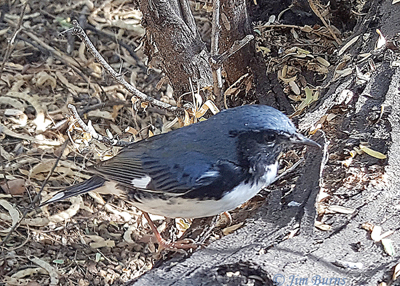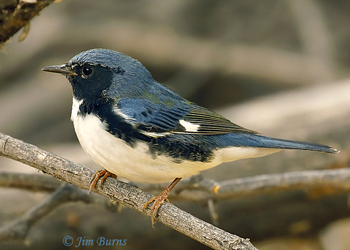
Every birding tale has a beginning, but this one may be my story of a lifetime, so I’m unsure where to start. My first bird, the first I remember seeing and for which I was given a name, was a Cedar Waxwing, but I was just a pre-school toddler. Studies and sports intervened, as they will, for twenty years, and I had no interest in sightings or names again until, as a young adult, my future wife and I were attacked by a Red-winged Blackbird while portaging near its nest in the Boundary Waters Canoe Wilderness Area in northern Minnesota.
Not long after, on a fine spring day and newly equipped with my first field guide, I took my lunch break along a wooded creek a stone’s throw from my workplace in central Iowa. Somewhere I had recently read warblers described as the “butterflies of the bird world,” tiny, colorful, active and hard to see well as they flitted through the foliage gleaning caterpillars. Naively, and without binoculars, I thought I might spot one and identify it. And I did!
Bright yellow in eye smashingly stark contrast to the dark green foliage, I nailed my first warbler, a yellow warbler, my first Yellow Warbler. I have never considered Yellow Warbler my “spark” bird (Western Tanager) or warblers my favorite family of birds (owls), but every spring day after that I took my binoculars to work, ate outside, and glassed for warblers. Totally hooked would be an understatement. And that first spring I was rewarded with Cape May, Yellow-rumped (Myrtle), Blackpoll, Pine, Common Yellowthroat, Yellow-breasted Chat, and American Redstart.
Subsequently a handful of trips to Point Pelee in Ontario and Magee Marsh in Ohio enabled me to find many of the remaining “eastern” warblers. Oddly enough, though, my last first for these was Black-throated Blue, not all that uncommon, but I did not find one until after I had seen the much rarer Blue-winged and Cerulean and the OMG skulkers, Swainson’s and Connecticut.
And then, last October, a hatch year male Black-throated Blue inexplicably showed up at the Gilbert Riparian Area in metro Phoenix. On “Bluey’s” third day (a friend anointed him with that name) I masked up and braved the scrum of birders, veterans and newbies alike, who had heard the news on social media. I got a few photos, then got out of there, the lack of social distancing driving me crazy.
Satisfied with my photos, but remembering the many unsuccessful searches for this species early in my birding career, I decided to go back some mid-afternoon to avoid the crowds of Bluey admirers and spend some quiet time, just the bird, me, and my camera. This idea was predicated on the bird’s affinity for one relatively small patch of mesquite and his remarkable obliviousness to those crowds plus the runners and dog walkers along the popular path where he taken up temporary residency.
For a previous generation of birders, “confiding” was a term, perhaps British in origin, for tame. I’ve assumed Bluey was totally confiding because he was an inexperienced hatch year bird and his wayward migration route had made him voraciously hungry. I had also made a mental note of a few of his favorite perches, just inches above the ground covered in mesquite leaf duff where he invariably returned to glean tiny insects.
When I arrived, no one else was around and neither was Bluey. Glancing at my watch, I sat down on a low mesquite branch in the middle of his favored territory to wait, curious to see if my plan was ill conceived or genius. Three minutes later he flew into a tree across from me, looked around, then came over, dropped down, and landed beside me. At arm’s length! Within inches! Have I explained totally confiding? Totally useless describes the zoom lens I had on the camera.
My second thought, after I looked around for somebody, anybody, with whom to share this once in a birding lifetime moment, was to realize rooting around in my camera bag for my macro lens might freak him out and ruin the moment. So . . . sure, I pulled out my cell phone. Not great pictures, but the best one accompanies this article. The other photos were taken with the macro lens a little later that afternoon.
We played this scenario out for at least half an hour. He’d drop to the ground, fly up with something indecipherably small, consume it, fly to another perch, maybe leave the immediate area but then fly back minutes later to sit beside me again. Sometimes I would stretch out my arms to get the macro lens or phone closer, sometimes I would slowly change position. Often I just sat there, marveling, reveling in the OMG moment, not even shooting.
Warbler with cell phone was a first for me, if not for humanity. At the intersection of birding and photography, warbler with cell phone is so far outside the realm of probability it does not compute. Hopefully it won’t be my last first, but I’m pretty sure it will be the last time I capture a warbler on my cell phone.
|
|
| Black-throated Blue Warbler--macro lens | |

